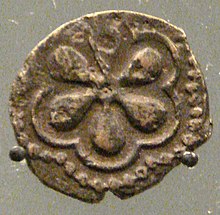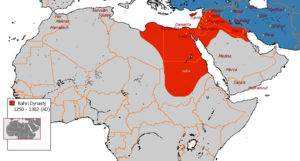an-Nāsir Muhammad ibn Qalāwūn
An-Nāsir Muhammad ibn Qalāwūn , also al-Malik an-Nasir ( Arabic الناصر محمد بن قلاوون, DMG an-Nāṣir Muḥammad ibn Qalāwūn ; * 1284 ; † June 1341 ) was Sultan of the Mamluks in Egypt from 1293 to 1341. He was the most important Mamluk sultan of the Bahri dynasty in Egypt .
Life
An-Nasir was a son of the Sultan Qalawūn († 1290). After the murder of his brother Chalil (1290–1293), the then eight-year-old an-Nasir was installed as sultan by the Mamluks . Because of his minority, the government was exercised by a council of the Mamlukenemirs, in which Khetbuga soon gained decisive influence. He pursued the murderers of Chalil and had himself proclaimed sultan in 1294. An-Nasir was exiled to Kerak.
After the government of Khetbuga (1294-1296) and Ladschin (1296-1299) an-Nasir was again proclaimed sultan in 1299, now at the age of fourteen, but was under the supervision of the emirs Salar and Baybars. The young an-Nasir had to face the Ilkhan army (allegedly 100,000 men) in Syria in the same year . The Mongols first triumphed in December 1299 in Wadi al-Khazindas near Hama and conquered Damascus . The Mongols, however, were satisfied with this conquest. An-Nasir was able to gather new troops and , in 1302, militarily put an end to the last attempt by the Templars , allied with the Mongols, to establish a base on the island of Arwad near Tartus . In the following year an-Nasir achieved a decisive victory in the battle of Shaqhab (April 20/21, 1303), which removed the Mongolian threat to the Mamluk Empire.
Despite this great success, an-Nasir was ousted by the government after his return to Cairo by Salar and Baybars. Although they were able to subjugate the Egyptian Bedouins after a massacre (allegedly 16,000 dead) (1306), the empire got into a crisis due to a severe earthquake (1303) and campaigns by the Johanniter against the Nile Delta, Acre and Tartus. In order to evade the supremacy of the emirs, an-Nasir withdrew to Kerak in the Jordan region in April 1308 and announced his abdication . He used his stay in Kerak to find allies among the Bedouins and the Syrian Mamluks , with whom he overthrew his successor Baibars II as early as 1309 .
Now an-Nasir could disempower the emirs and take over personal government. In the period that followed, he promoted the construction of irrigation systems. In addition, the finances were reorganized, taxes for large landowners were increased and levies on salt, sugar, poultry, etc. abolished. Because of previous bad harvests, sharp action was taken against usurers. Against the resistance of the Mamluks, An-Nasir also managed to redistribute the military fiefs in favor of the sultan and the fighting troops. This initially prevented the formation of a feudal Mamluk upper class.
In terms of foreign policy, an-Nasir contented himself with securing the empire. In 1323 a peace treaty was concluded with the Il-Khans of Persia . In the Hejaz and in Nubia , sovereignty was secured through expeditions.
The country's prosperity enables extensive construction activity and the promotion of science. So was u. a. the mosque was built on the Cairo Citadel . A short-term economic crisis was triggered by the Mecca pilgrimage of the fabulously wealthy King Mansa Musa of the Mali Empire in 1324. Several Egyptian chroniclers unanimously report that the purchases made by the king and his companions brought so much gold to the Cairo market that the gold price fell dramatically. According to modern calculations, the price drop must have been around 25% and should not have recovered until decades later.
An-Nasir died in June 1341. After the emirs had to swear to him to appoint his descendants as successors, twelve of his sons and grandchildren, mostly in childhood, were appointed sultans by 1382; but they were under the control of the emirs. The latter were able to further strengthen their power, so that the Mamluks developed into a powerful feudal class against which the sultans could hardly rule in the future.
literature
- David Abulafia, Rosamond McKitterick: The New Cambridge Medieval History. c. 1198-c. 1300. Cambridge University Press, Cambridge / New York 1999, ISBN 0-521-36289-X , p. 621.
- Amalia Levanoni: A Turning Point in Mamluk History. The Third Reign of Al-Nasir Muhammad Ibn Qalawun (1310-1341). Brill, 1995. ISBN 978-90-04-10182-1 .
Individual evidence
- ^ Levtzion: Ancient Ghana. 66, pp. 209-213.
| predecessor | Office | successor |
|---|---|---|
|
Khalil Ladschin Baibars II. |
Sultan of Egypt ( Bahri dynasty ) 1293–1294 1299–1308 1309–1341 |
Khetbuga Baibars II al-Mansur Abu Bakr |
| personal data | |
|---|---|
| SURNAME | Nāsir Muhammad ibn Qalāwūn, an- |
| ALTERNATIVE NAMES | Malik an-Nasir, al- |
| BRIEF DESCRIPTION | Sultan of the Mamluks in Egypt |
| DATE OF BIRTH | 1284 |
| DATE OF DEATH | June 1341 |

